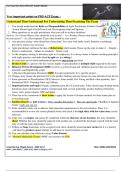Summary
Summary PMI-ACP EXAM : VERY IMPORTANT PIONTS UPDATE
- Course
- Institution
Understand Then Understand For Understating Then Practicing The Exam 1. You should understand the Roles and Responsibilities of Agile Practitioner -Product Owner -Scrum Master/Agile Coach/Team Lead, Development team and Sponsor. 2. Many questions as an agile practitioner what you will do in thes...
[Show more]



